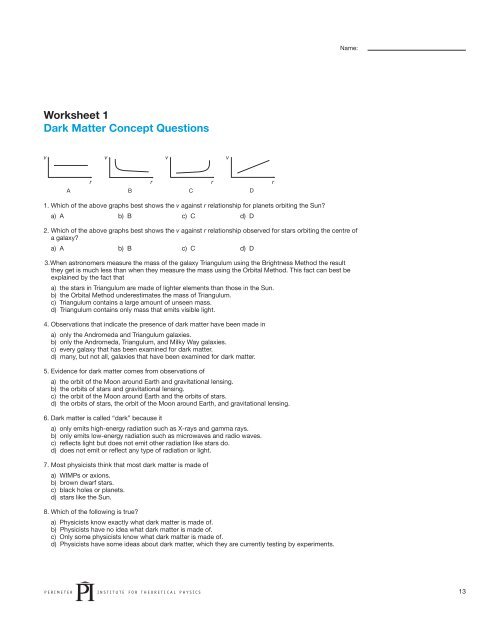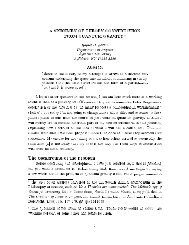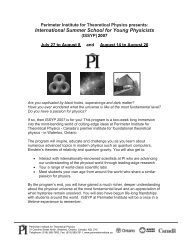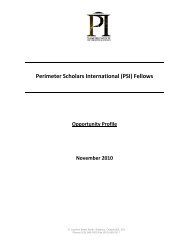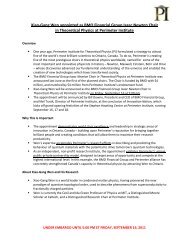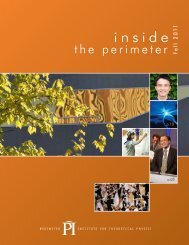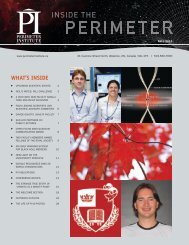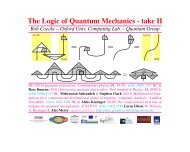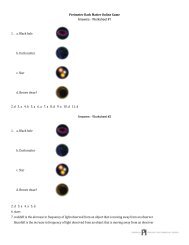Dark Matter Teacher Guide - Perimeter Institute
Dark Matter Teacher Guide - Perimeter Institute
Dark Matter Teacher Guide - Perimeter Institute
You also want an ePaper? Increase the reach of your titles
YUMPU automatically turns print PDFs into web optimized ePapers that Google loves.
Worksheet 1<br />
<strong>Dark</strong> <strong>Matter</strong> Concept Questions<br />
v v v v<br />
r r r r<br />
1. Which of the above graphs best shows the v against r relationship for planets orbiting the Sun?<br />
a) A b) B c) C d) D<br />
Name:<br />
2. Which of the above graphs best shows the v against r relationship observed for stars orbiting the centre of<br />
a galaxy?<br />
a) A b) B c) C d) D<br />
3.When astronomers measure the mass of the galaxy Triangulum using the Brightness Method the result<br />
they get is much less than when they measure the mass using the Orbital Method. This fact can best be<br />
explained by the fact that<br />
a) the stars in Triangulum are made of lighter elements than those in the Sun.<br />
b) the Orbital Method underestimates the mass of Triangulum.<br />
c) Triangulum contains a large amount of unseen mass.<br />
d) Triangulum contains only mass that emits visible light.<br />
4. Observations that indicate the presence of dark matter have been made in<br />
a) only the Andromeda and Triangulum galaxies.<br />
b) only the Andromeda, Triangulum, and Milky Way galaxies.<br />
c) every galaxy that has been examined for dark matter.<br />
d) many, but not all, galaxies that have been examined for dark matter.<br />
5. Evidence for dark matter comes from observations of<br />
a) the orbit of the Moon around Earth and gravitational lensing.<br />
b) the orbits of stars and gravitational lensing.<br />
c) the orbit of the Moon around Earth and the orbits of stars.<br />
d) the orbits of stars, the orbit of the Moon around Earth, and gravitational lensing.<br />
6. <strong>Dark</strong> matter is called “dark” because it<br />
a) only emits high-energy radiation such as X-rays and gamma rays.<br />
b) only emits low-energy radiation such as microwaves and radio waves.<br />
c) reflects light but does not emit other radiation like stars do.<br />
d) does not emit or reflect any type of radiation or light.<br />
7. Most physicists think that most dark matter is made of<br />
a) WIMPs or axions.<br />
b) brown dwarf stars.<br />
c) black holes or planets.<br />
d) stars like the Sun.<br />
8. Which of the following is true?<br />
a) Physicists know exactly what dark matter is made of.<br />
b) Physicists have no idea what dark matter is made of.<br />
c) Only some physicists know what dark matter is made of.<br />
d) Physicists have some ideas about dark matter, which they are currently testing by experiments.<br />
13


